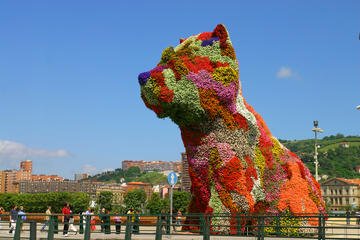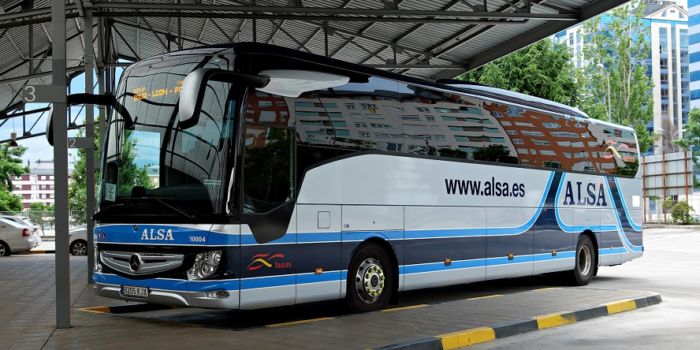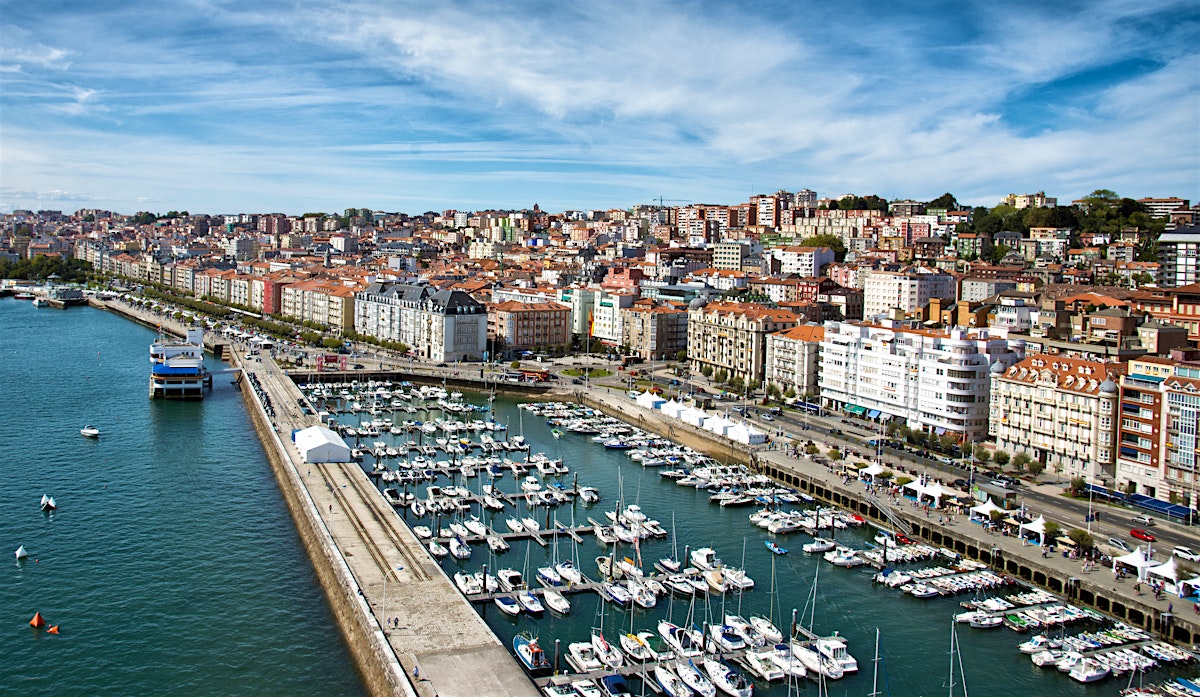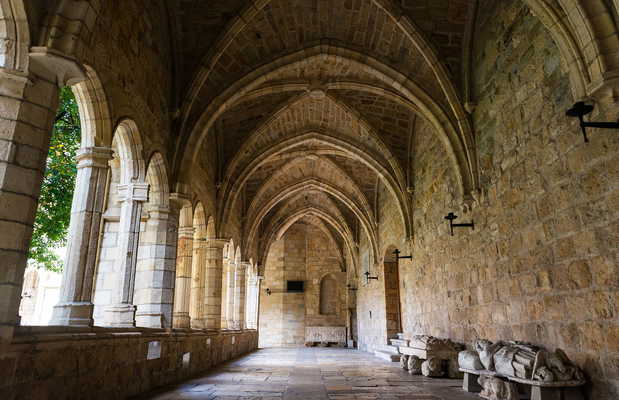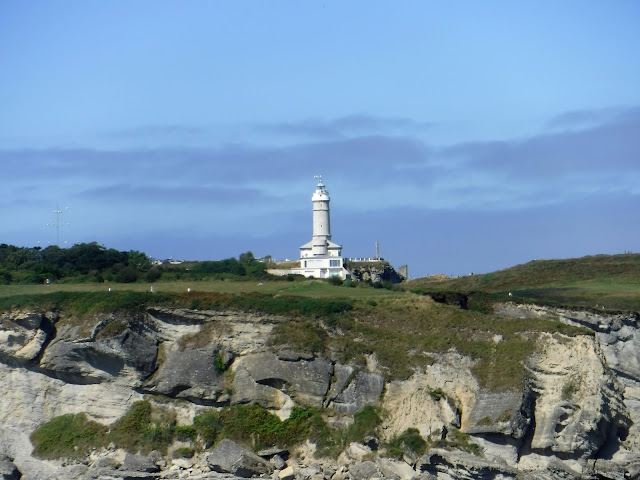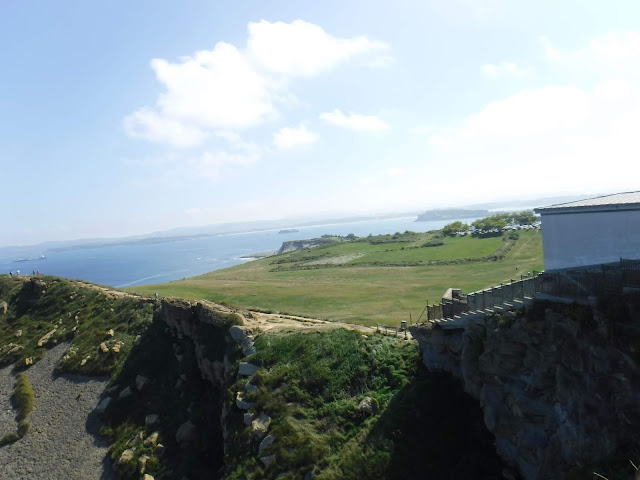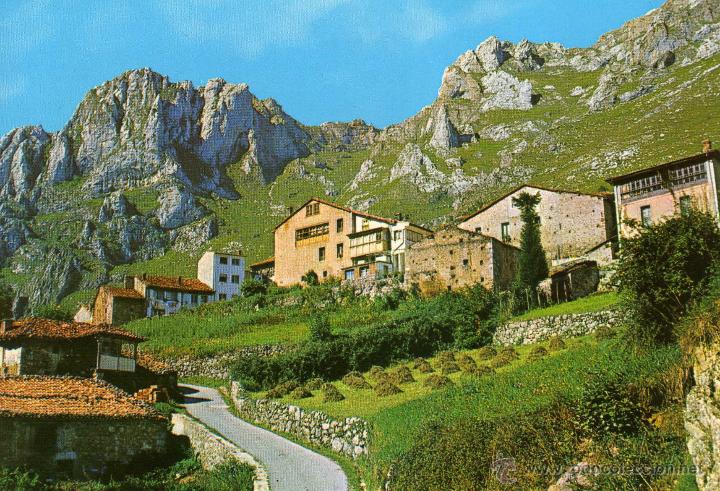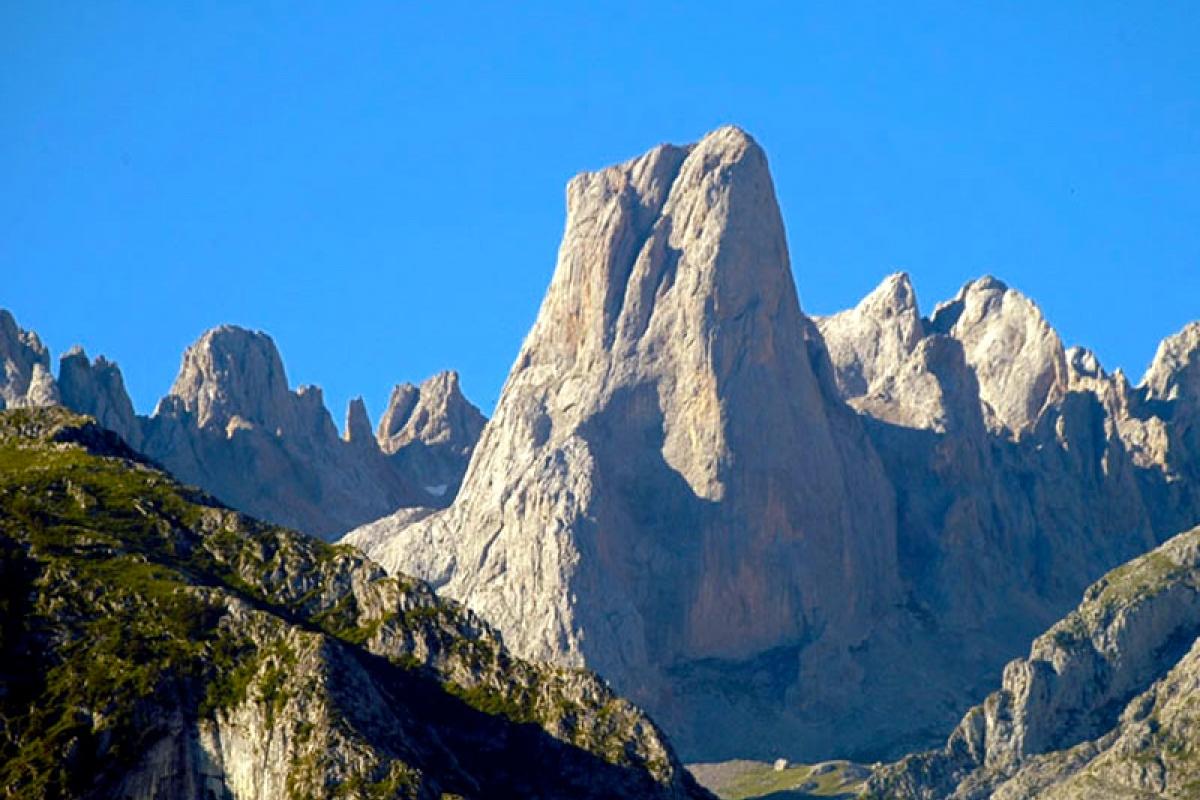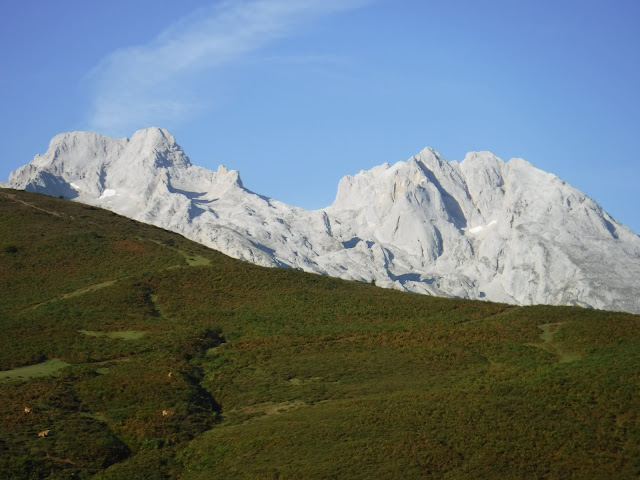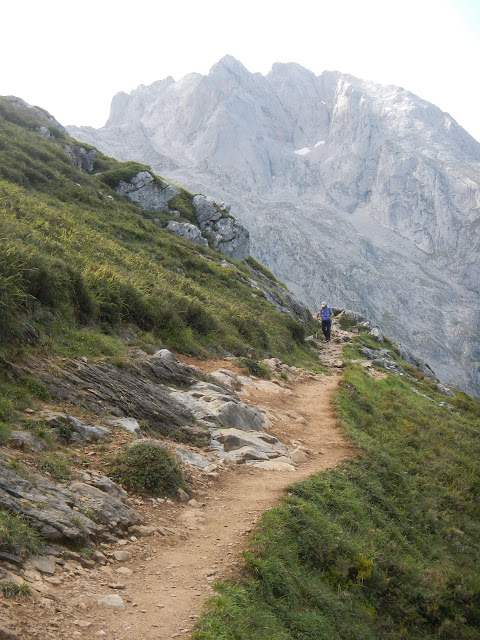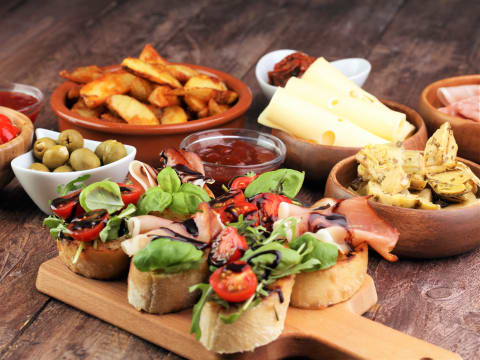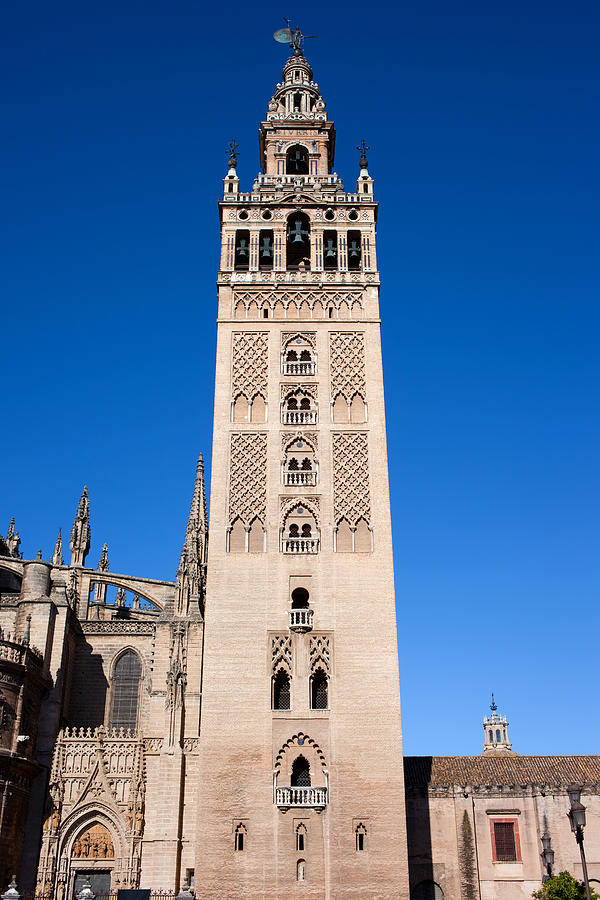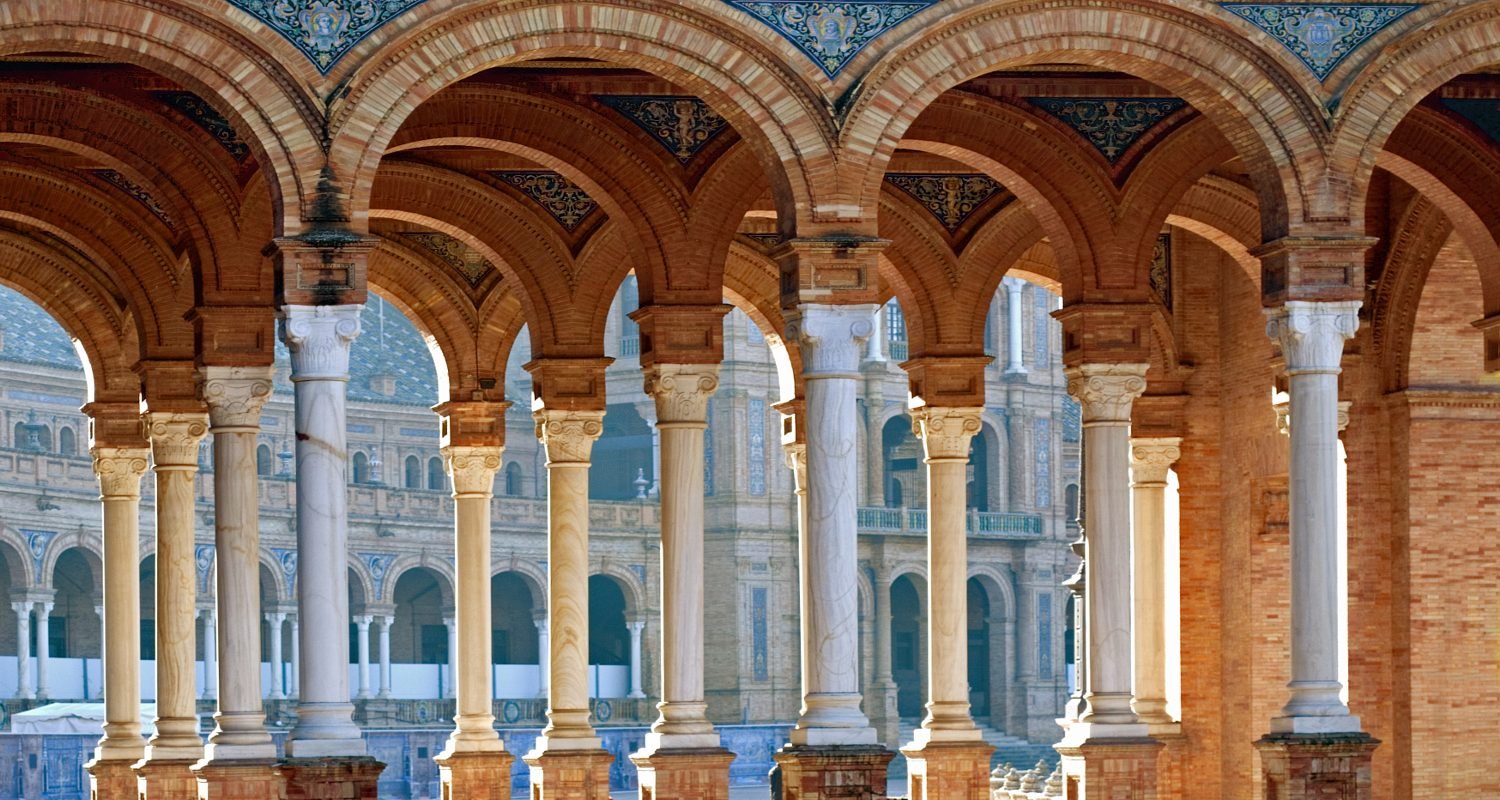September 20, 2018

Today we took the train to San Sebastian, a resort town located on the Bay of Biscay in Spain's mountainous Basque country. It is renowned for Playa de la Concha and Playa de la Ondarreta, golden beaches framed by the picturesque promenade and capped by white peaks at either end with an island in the middle. San Sebastian is also renowned for its world-class restaurants helmed by innovative chefs!
The Basque word for "San Sebastian" is "Donostia" which the locals shorten to "Donosti". San Sebastian is listed on maps and in the guide books, but the name San Sebastian does not exist on the train schedule, but Donostia does!


The train was on time and as with all public transportation we have experienced here, it was new and spick and span clean. The 2.5 hour journey went quickly and we enjoyed seeing the verdant bucolic countryside pass by.
We arrived right on time. As we exited the train station, we were greeted by a crystal clear, stunningly beautiful blue sky and 87 degrees with a cool sea breeze day!

On our short walk to the beach, we passed flowers galore all with vibrant, vivid colors.

Within a few minutes, we were at the shimmering turquoise and indigo blue Bay of Bisque! Sparkling white sand with hundreds of sunbathers lay to the right and left of us... the beaches of Playa de la Concha and Playa de la Ondarreta create perhaps the most iconic sight in San Sebastian.


We walked the 3 mile promenade above the white soft sand and clear water of the gently breaking turquoise waves in this beautiful shell shaped bay.

We arrived right on time. As we exited the train station, we were greeted by a crystal clear, stunningly beautiful blue sky and 87 degrees with a cool sea breeze day!


Within a few minutes, we were at the shimmering turquoise and indigo blue Bay of Bisque! Sparkling white sand with hundreds of sunbathers lay to the right and left of us... the beaches of Playa de la Concha and Playa de la Ondarreta create perhaps the most iconic sight in San Sebastian.


We walked the 3 mile promenade above the white soft sand and clear water of the gently breaking turquoise waves in this beautiful shell shaped bay.

Considered the culinary capital of Spain, many San Sebastian local restaurants have gained international fame, so we decided to walk past the touristy area in this beach resort town and find a restaurant where the locals eat their lunch.
We walked past the calm waters of the firmly packed harbor
to the farthest part of the pier where the rocks below are acutally the imperfect, cast-off square marble blocks once used for the historic buildings which now lay on the side of the sea below the pier.
It was there that we found the restaurants frequented by the locals.
As part of our delicious 3-course lunch, this restaurant served us the freshest scallops and prawns in a delectable sauce. It's easy to see why San Sebastian has the reputation it does for savory cuisine. Photos do not do this part of the meal justice!
After lunch, we walked quite a way around the old fort and saw the waves smashing against the breakwater. Way around the corner there's a beach with a surfers' paradise.
We strolled throughout Old Town, Parte Vieja, with its cobblestone streets and historical architecture. Some of the highlights include:
Ayuntamiento (City Hall)

This served as a casino when it was built at the end of the 1800's with its Belle Epoque twin towers. It is now the city hall and main library and has an inviting play area with a two-story carousel for children of all ages.
San Vicente Church
San Vicente church was built in the Gothic style architecture during the 15th and 16th centuries. It has soaring ceilings and stunning stain glass rose windows.
Basilica of Saint Mary of Chorus
Around the Old Town streets a gorgeous Catholic church in the baroque style of architecture looms large! It is the Basilica of Saint Mary of Chorus. It was completed in 1774 after 21 years of construction. It is the most important church in Old Town and one of the most emblematic churches in San Sebastian.
Plaza de la Constiticuon
Plaza de la Constiticuon lies deep in the heart of Old Town. The balconies that line the square display numbers dating back to the time it was used as a bullring.
Old Town has lovely apartment buildings
with restaurants on nearly every street corner.

or walking along the beach, we were always in full view of the statue of Jesus soaring high overhead with his arms outstretched.

Later on, as we walked back towards the beautiful beach
we passed this gentleman writing a message in the sand.

The Basque are proud people with their own language which predates Latin by centuries! The Basques want to be free from Spain and France and be an independent nation. That's what this gentleman's message is all about, words reflecting his passion for his "country", words which will be washed away in the next high tide.
Plaza de Guipuzkoa
We walked back to the train via this beautiful, quiet garden area with its lush manicured lawns and radiant flowers.
back towards town.

It was time to catch the train back to the Bilbao train station

Bilboa's train station
where we exited in the early evening. We knew we had tapas-bars full of pintxos delicious delights waiting for us.
We will need all the nourishment for tomorrow will be our last day in Bilbao and we still have many sights to see, namely the Guggenheim museum.
September 21, 2018
__________________________________________________
The Guggenheim Museum in Bilbao, Spain
_________________________________________________

Welcome to the Bilbao Guggenheim Museum, one of the most dynamic designs in modern architecture!

It was designed by Frank Gehry and since it opened in 1997 it has been hailed by both the public and critics alike as one of the most important structures of contemporary architecture.
Guarding the entrance to the Guggenheim

is a 42 foot high West Highland Terrier with 60,000 (yes, 60 thousand!) plants and flowers
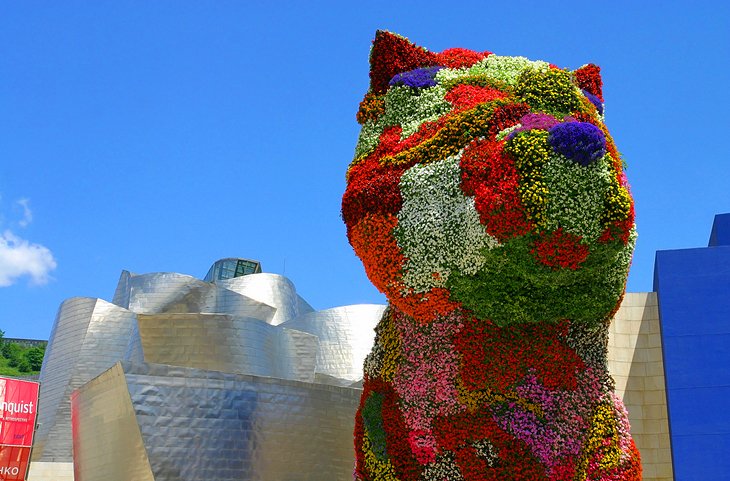
which grow thru the steel mesh and are watered daily internally. Designed by Jeff Koons this impressive living sculpture is appropriately and lovingly called "Puppy".
The Guggenheim is a masterpiece of contemporary design!


The building is wrapped in 33,000 titanium panels resembling the fish scales of a carp. As the brochure informed us, "this design creates what appears to be random organic curves." In addition to the fish symbolism, these panels were designed to capture light.
For this reason, the building takes on a different appearance at night as the city lights reflect off of it. Below is the lovely brochure cover commemorating last year's twentieth-anniversary of the Guggenheim Bilbao museum.

Outside there is a water garden which allows the river to lap at the base of the building.


When viewed from the river, Maman is clearly visible. Also when viewed from the river, the Guggenheim resembles an abstract ship which was Ghery's intent as he paid homage to Bilbao's Nervion River that historically had provided prosperity to Bilbao.

Just walking around the exterior of the Guggenheim
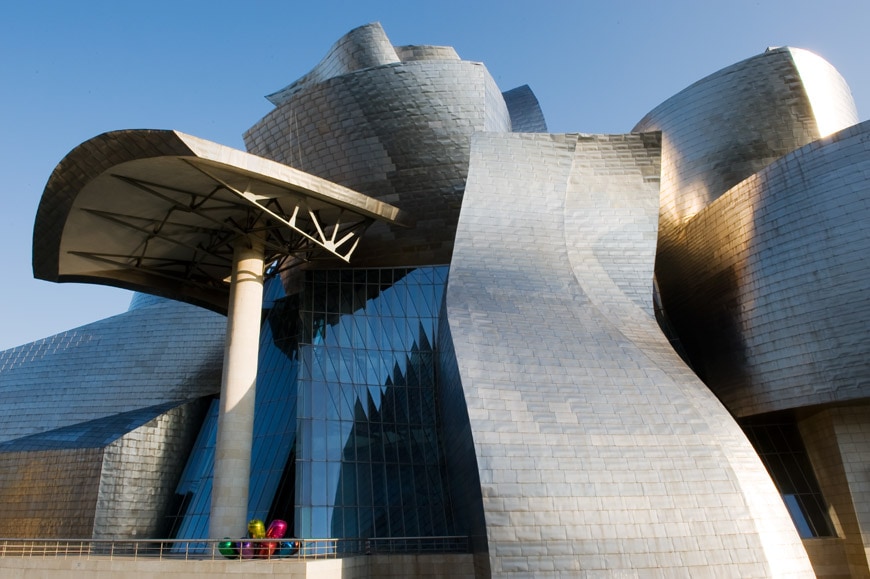
is impressive in and of itself.


But once you enter, you'll find that the interior of the Bilbao Guggenheim is a just as extraordinary as the outside! It is a sight to behold!
When you enter, your jaw may very well drop in awe for you can not help but look upwards.
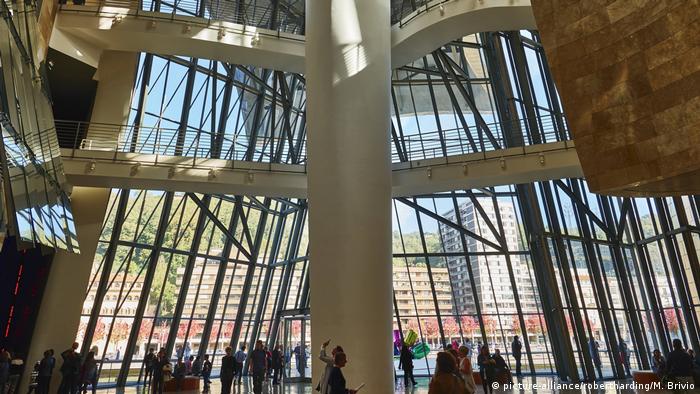


EVERY surface is curved.
The only straight architectural lines are the flat floors!
There's even a curved
Glass Staircase
Glass Staircase


which is suspended from the ceiling and appears to be floating in space.
But a true marvel of modern engineering is the curved glass elevator.
Curved Glass Elevator

This impressive glass elevator that appears to be clinging to the wall is comprised of hundreds of individual sheets of glass overlapping each other, like a fish scale. These were designed by a computer and shaped by a robot. Quite impressive for 1997.
The exhibition rooms are also curved as is this permanent collection. It is the centerpiece of the museum, Richard Serra's The Matter of Time.
At first one might not realize that you may enter and experience these pieces of art.

This series of 8 sculptures literally tower over you as you walk in-between and around.
Here's what the museum curator wrote about this exhibit:
"This is a piece of art that on the surface can have little meaning. It can be just big chunks of twisting bronze metals. Serra's idea is more about the emotional experience than intellectual connection. You are the art."

There is a lot of art to experience both inside and out.
Even Yoko Ono has a "living" art contribution

A Wish Tree for Bilbao from Yoko Ono. "A soil and olive tree from which wish cards are hung on certain dates."
There were many masterpieces on loan from other Guggenheim museums. On exhibit were numerous exquisite paintings by Monet, Manet, Degas, and Renoir.
We also enjoyed viewing Andy Warhol's One hundred and Fifty Multicolored Marilyns.
One final comment about our time experiencing the Bilbao Guggenheim.
We also enjoyed viewing Andy Warhol's One hundred and Fifty Multicolored Marilyns.
One final comment about our time experiencing the Bilbao Guggenheim.
In the main foyer, there was a whimsical three stories of a colorful creation. Suspended from on high, it greeted visitors not just in front of the curved glass elevator,

__________________________________________________
Santander, Spain...One of Spain's Best Kept Secrets!
_________________________________________________
The Bahia Hotel was our home for 2 days. Our room had a scenic view of Santander's wide bay overlooking the Cantabrian Sea backed by the Cantabrian Mountains.
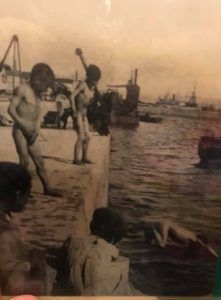
As we walked by "The Raqueros" statues
Santander, Spain...One of Spain's Best Kept Secrets!
_________________________________________________
September 22-24, 2018
Santander, Spain
Today we travelled by bus from Bilbao to Santander, Spain. Situated on the northern coast, Santander is a mere 68 miles to the west of Bilbao.
Our bus was with the ALSA bus company and it was new, spic and span clean, on time and gave us a very pleasant and enjoyable hour ride from Bilbao to Santander.
Santander is the capital of the autonomous region of Cantabria and the city has many historic government buildings.
To those who live in Santander, it is a bustling city and home to the 4th largest bank in the world! The bank is appropriately named Santander, or Banco de Santander. Its global headquarters is an impressive massive structure which encompasses 3 city blocks.
But Santander is also a Spanish resort community
whose beautiful Mediterranean-like beaches hug the coastline and attract tourists from all across Spain. Very few Europeans outside of Spain have discovered it. They typically vacation in the south of Spain. And because it is listed in only a few guidebooks, Santander is considered one of Spain's best-kept secrets!
We arrived to blue skies and a soft sea breeze.
The Bahia Hotel was our home for 2 days. Our room had a scenic view of Santander's wide bay overlooking the Cantabrian Sea backed by the Cantabrian Mountains.
We had a busy 2 days for we saw many sights, spent time on its beautiful beaches, ate extraordinary food and saw a bit of the old Camino del Norte.
The Camino del Norte is the Northern Way that took pilgrims across the Basque country to Santiago de Compostela. Here is the symbol that people today look for in order to stay on the Camino del Norte.

This one led to the gorgeous Santander cathedral, also named the Cathedral Basilica of the Assumption of the Virgin Mary of Santander.

This one led to the gorgeous Santander cathedral, also named the Cathedral Basilica of the Assumption of the Virgin Mary of Santander.
It was a stunningly beautiful day as we walked to this majestic cathedral!
As we were admiring the serene grounds, we were told that the cathedral was closed for sightseeing for there was to be a wedding.
As we walked down the stairs to the street, who should arrive and step out of her chauffeur-driven black Mercedes but the bride along with her father and her precious 3 little flower girls. It was a beautiful sight.
The lovely little girls with flowers in their hair and their matching dresses giggled as they tried to get the stunning wedding dress' very long train positioned properly behind the bride. The father of the bride looked appropriately proud but somewhat oblivious to the situation. The bride was ready to get the show on the road telling everyone what to do!
The lovely little girls with flowers in their hair and their matching dresses giggled as they tried to get the stunning wedding dress' very long train positioned properly behind the bride. The father of the bride looked appropriately proud but somewhat oblivious to the situation. The bride was ready to get the show on the road telling everyone what to do!
A few hours later, the area outside the church was filled with over 100 children and families of small children eagerly awaiting the featured clown to perform as part of the annual cultural events program. It was great fun!


From our hotel, we only had to walk a block to find fantastic restaurants with outdoor cafes. Our location was within walking distance of the historic section.
Santander has managed to successfully retain much of its long history, old landmarks and monuments to the past, in spite of a major city fire in 1941 that rampaged the city and burnt for 2 days leaving much of the city devastated. But Santander has rebuilt and has restored its damaged historic buildings, retaining its heritage and has even created many new ultra-modern and futuristic structures such as the Centro Botin below
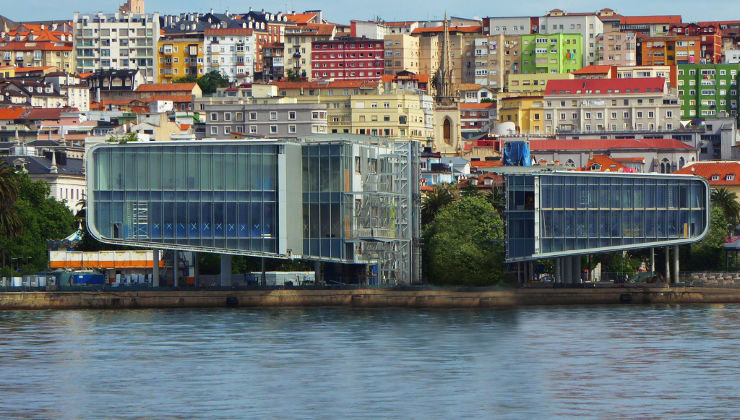
Over the course of our stay, some of the sights we saw along the way included
The Town Hall

Church of the Annunciation

One of the oldest buildings in Santander is the Gothic style Cathedral Nuestra Senora de las Asuncion. Much was destroyed in the fire of 1941 but has been lovingly and carefully restored with portions rebuilt. It reopened in 1953. Traces of the Roman era were discovered here during this restoration.

The Plaza Porticada
We walked past rows of lovely high-end apartments on the water.

As we headed to the lighthouse we passed a golf course high above the beach.

You can see the green in the photo above and below.


Santander has lovely gardens

We were right near the Puertochio which was formerly the main fishing port. Today Puertochio is considered the upscale part of town and a great area for families to enjoy.
We walked the Puertochio and passed by "The Raqueros" which are sculptures of four boys ready to dive into the bay. They are to remind us of a time during the 1800's when passengers from the steamships arriving into port would throw pennies into the water and watch the local children dive to collect them.
Santander has managed to successfully retain much of its long history, old landmarks and monuments to the past, in spite of a major city fire in 1941 that rampaged the city and burnt for 2 days leaving much of the city devastated. But Santander has rebuilt and has restored its damaged historic buildings, retaining its heritage and has even created many new ultra-modern and futuristic structures such as the Centro Botin below

Over the course of our stay, some of the sights we saw along the way included
The Town Hall

Church of the Annunciation

One of the oldest buildings in Santander is the Gothic style Cathedral Nuestra Senora de las Asuncion. Much was destroyed in the fire of 1941 but has been lovingly and carefully restored with portions rebuilt. It reopened in 1953. Traces of the Roman era were discovered here during this restoration.

The Plaza Porticada
Lots of fun shops lining the streets with handmade intricate and elaborate items for sale.
to the Centro Botin on the beach.
We walked to the beaches and they were lined with bathers and sun worshipers as far as the eye could see.

As we headed to the lighthouse we passed a golf course high above the beach.

You can see the green in the photo above and below.

A beautiful spot to play golf!

Santander has lovely gardens

and a stunning lighthouse.
It was a beautiful day to walk out to the end.
On our way back home we passed more scenic seashore spots all sporting panoramic views.
This palace of a building is a casino. We went inside to look around and they carded us! Seems to be the law in Spain. It had an amazing interior.
We walked the Puertochio and passed by "The Raqueros" which are sculptures of four boys ready to dive into the bay. They are to remind us of a time during the 1800's when passengers from the steamships arriving into port would throw pennies into the water and watch the local children dive to collect them.
Here's the original photo from which the sculpture drew his inspiration.

As we walked by "The Raqueros" statues
The Plaza Plumb
where we saw children and adults alike enjoying the two-story carousel!
and women chatting together in the late afternoon sun
As twilight fell, we watched the new and the old Santander with the Centro Botim looming overhead pointing out to sea as the fisherman below, doing what his forefathers have done for generations, searching the horizon for his dinner and casting his line out to sea.
We found Santander to be a charming city surrounded by a beautiful sea, scenic mountains, rich culture and filled with family-friendly fun.
Here's to our wonderful stay in Santander!
__________________________________________________
Hiking the Picos De Europa... Days 1 and 2 Arenas de Cabrales to Nava
_________________________________________________
9 Days Hiking the Picos de Europa
__________________________________________________
Hiking the Picos De Europa...Day 3 Tielve to Sotres
_________________________________________________
We passed summer huts for the shepherds
Once at the top,
We began our descent.

We simply could not have asked for a more pristine day filled with such spectacular views!
As we descended we soon spotted our day's destination, Sotres!

This peaceful hamlet of Sotres, the highest village in the Picos de Europa, would be our home for the next four nights.

__________________________________________________
Hiking the Picos De Europa... Day 4 Ascent to Vega de Urriellu
_________________________________________________
We started out hiking up to the Collado Pandebano
Then over the rise.
The views were amazing every step of the way!

There was one spot where we just had to sit and inhale the view.
Pictures do not do it justice for this was exceptional. In the distance, we could see the Cantabrian Sea! It is hard to tell from the photos below, but it was a glorious sight.
__________________________________________________
Hiking the Picos De Europa... Day 5 Hitu to Caseton de Andara and back to Sotres
_________________________________________________
The terrain was quite varied today with everything from steep rocky trails



to numerous cols and then rolling cow paths.

We started our hike with an ascent via an unused mining track which wound around
the mountain and led us to some stunning views of the Cantabrian Sea and the Bay of Biscay!

You can see our trail cut in the mountain in the distance.


As we continued up we had a great view.


We continued our ascent
along a former mining track which took us to an abandoned ore mine



and to refugio Caseton de Andara

which was wedged into the rock wall.
From there we ascended up a steep path

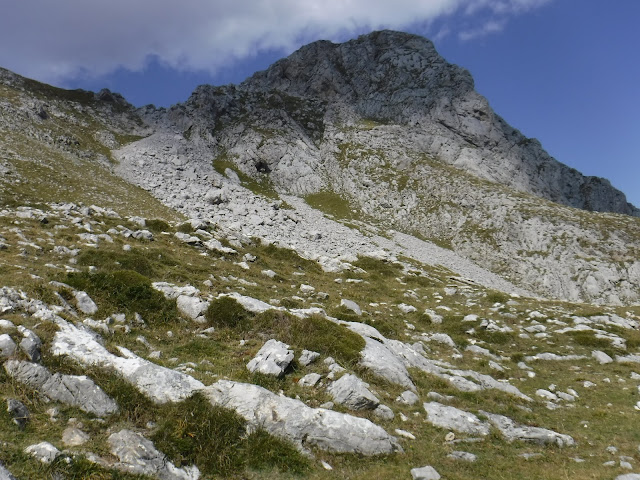
where we saw vultures and eagles soaring on the thermals overhead.
It was a lovely view from our lunch spot.



Time to head on down


to the long way back to Sotres.
Our descent was primarily across several cols.
We stopped for a while on this lovely vista. I looked down at the stone to see that large letters were written on it spelling "SOTRES" with an arrow pointing the way!

thru farmers' high alpine cow pastures

to the valley below

until finally to the road to Sotres.
__________________________________________________
Hiking the Picos de Europa...Day 7 Sotres to Bulnes to Poncebo
_________________________________________________
Hiking the Picos de Europa...Day 7
Sotres to Bulnes to Poncebos
From Sotres we arrived at Pandebano to the beautiful view of Pico Urrielle.

Today we are off on a very steep 6 mile downhill hike (4,001 foot of a descent!) to the hamlet of Poncebo.
When we started our hike at Pontebano, we saw a female cow licking her calf in the warm morning sunshine. It was a heartwarming sight.
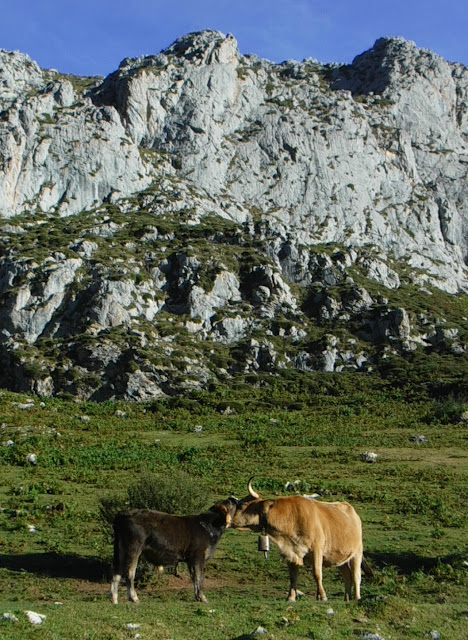

and our once lovely blue sky hiking day became one of a foggy, steep, quite slippery, rocky way down to Bulnes.

Bulnes is a small rustic hamlet that until recently was totally isolated from road access. In fact, its only access was available by foot from the village of Poncebo on the canyon floor below or from the village of Pandebano on the long slippery trail we had just traveled.
However, recently they built a funicular to encourage tourism. The funicular connects the village of Bulnes to Poncebo on the canyon floor below. It transports food and mail from down below to Bulnes.


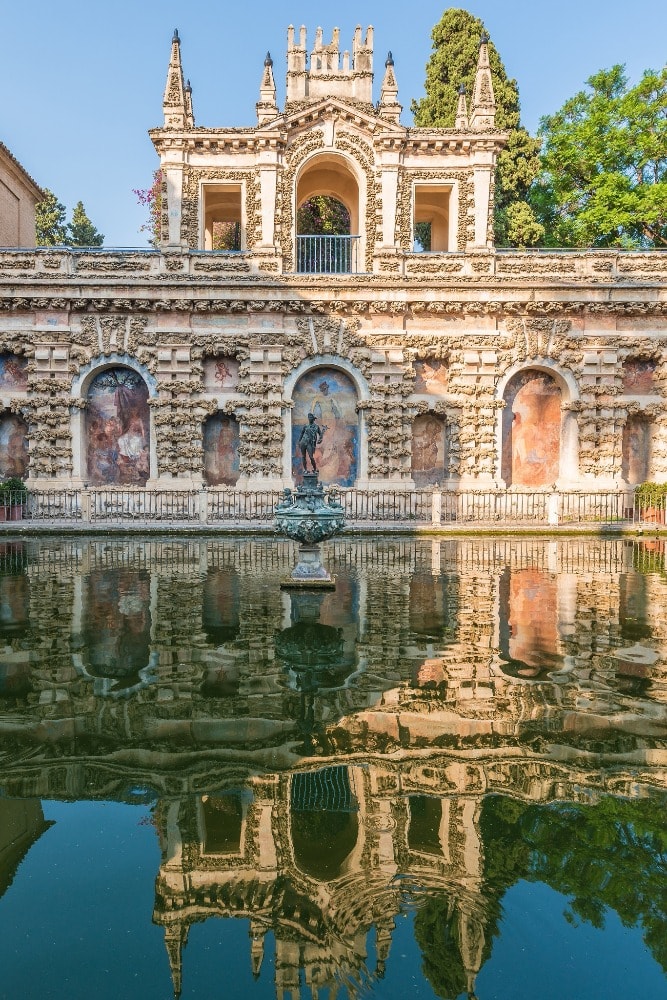
Hiking the Picos De Europa... Days 1 and 2 Arenas de Cabrales to Nava
September 24-October 2nd, 2018
9 Days Hiking the Picos de Europa
Santander is a mere 70 miles from the Picos de Europa National Park, but it might as well be a world away! In our steep high alpine hikes, we experienced 7 out of 10 days of not seeing anyone on the trails or in the hiking area itself except for a few lone wandering sheepherders. We stayed in little hamlets nestled in these steep mountains and fell in love with this pristine wilderness way of life in the Picos de Europa.
We are on the self-guided portion of our trip thru a 20 year old company specializing in this area called S-cape. The beauty is that they arrange all our transfers and hotel reservations since they have the local knowledge of the area. The best part is that they move our bags from point a to point b and all we have to do is carry our day packs and hike the many miles in the mountains between the two towns. It is a very smooth transition for traveling especially in the mountains.
Day1 and Day 2
Our ALSA bus dropped us off in Unquera and there our taxi, pre-arranged by S-Cape, was waiting for us. We were driven 20 miles, which took us an hour on the serpentine mountainous roads, to the village of Arenas De Cabrales where our hotel, appropriately named, Hotel Picos de Europa, was to be our home for the following 2 nights.
We are on the self-guided portion of our trip thru a 20 year old company specializing in this area called S-cape. The beauty is that they arrange all our transfers and hotel reservations since they have the local knowledge of the area. The best part is that they move our bags from point a to point b and all we have to do is carry our day packs and hike the many miles in the mountains between the two towns. It is a very smooth transition for traveling especially in the mountains.
Day1 and Day 2
Our ALSA bus dropped us off in Unquera and there our taxi, pre-arranged by S-Cape, was waiting for us. We were driven 20 miles, which took us an hour on the serpentine mountainous roads, to the village of Arenas De Cabrales where our hotel, appropriately named, Hotel Picos de Europa, was to be our home for the following 2 nights.
The following morning we hiked out of the quiet village on a loop trail from Arenas to Nava. It was a beautiful, clear blue sky day with fantastic visibility, the perfect complement for an adventure in the mountains.


These mountains are jagged limestone sentinels which have an unusual terrain and seemingly untamed hillsides with very long steep climbs to scenic ridges but once there provide magnificent views.



It was a beautiful day for our 7 mile trek where we ascended 2,113 vertical feet and hiked on rocky limestone trails thru varied landscapes. Often when the trail goes up it is on a narrow goat path.



These mountains are jagged limestone sentinels which have an unusual terrain and seemingly untamed hillsides with very long steep climbs to scenic ridges but once there provide magnificent views.



It was a beautiful day for our 7 mile trek where we ascended 2,113 vertical feet and hiked on rocky limestone trails thru varied landscapes. Often when the trail goes up it is on a narrow goat path.

We traversed from one col to the next and then the next across the ridge.
On the third col we saw a herd of 50 plus sheep well camouflaged in the limestone terrain.
We stopped at the third col and had lunch enjoying the amazing panoramic view of the spectacular Picos de Europa peaks. We could see up and down two separate valleys!
We were hiking high on top of limestone, which was "polished", the product of having been weathered heavily by both wind and rain over centuries, creating a slippery rock surface.
After more traversing, we headed down
and our trail disappeared!
We were hiking high on top of limestone, which was "polished", the product of having been weathered heavily by both wind and rain over centuries, creating a slippery rock surface.
The limestone resembled large crevasses and jagged edges sticking up making travel very precarious.
We finally made it down to the trail below
having come down from this massive limestone massif.
Off in the distance, we could make out our destination.
We headed around the back side of the mountains.
We passed an old shepherd's hut and there were sheep grazing nearby.
In a while, we could see once again the red-roofed quiet village of Arenas de Cabrales far down below.
It was a glorious albeit steep hike today where we were totally immersed in the Picos de Europa's serene scenic beauty and the wonders of nature.
__________________________________________________
Hiking the Picos De Europa...Day 3 Tielve to Sotres
_________________________________________________
September 26th
Day 3 Hiking Tielve to Sotres
Today we will hike 6 miles with a 2,002 vertical ascent and 1,000 foot descent from the small village of Tielve to the tiny hamlet of Sotres, the highest village in the Picos de Europa.
With our bags packed, our driver picked us up and drove us for 20 minutes along a narrow, serpentine road to Tielve de Cabrales a very small village in the Picos de Europa mountains. This will be the start of today's hike to the hamlet of Sotres. After dropping us off at the trailhead, our driver will continue on with our bags to Sotres where they'll be waiting for us at the Sotres Hotel at the end of today's hike.
The trail started up quickly and soon we were above Tielve
and higher than the grazing sheep.
Hiking up to the first ridge and then the col, we had beautiful views.
Once over the ridge, we came across these friendly fellows.
They turned their heads to make sure that we were on our way.
We passed summer huts for the shepherds
The high meadow alpine views were spectacular!
We continued ascending the steep incline.
until we reached a seemingly endless field of ferns.
we were rewarded with a panoramic view of the Picos de Europa mountains. It was a beautiful bucolic scene right out of a picture postcard.

Every step of the way today it was hard to imagine a more peaceful, serene spot.
As we descended we soon spotted our day's destination, Sotres!

This peaceful hamlet of Sotres, the highest village in the Picos de Europa, would be our home for the next four nights.

Hiking the Picos De Europa... Day 4 Ascent to Vega de Urriellu
Hiking the Picos de Europa Mountains...Day 4 Ascent to Vega de Urriellu
One of the most spectacular hikes we have ever experienced was today's ascent to Vega de Urriellu in the Picos de Europa. It was breathtakingly beautiful and awe-inspiring.
The Urriellu peak itself is an incredible feat of nature as a massive tower of limestone jutting up above all the others in the area.
Right below the foot of Pico Urriellu is the Refugio Vega de Urriellu. In the photograph above, the refugio Vega de Urriellu is dwarfed by the face of Pico Urriellu , but you can make it out. It is located right above the words written in italic "the foot" in the first sentence. That's where we're headed. The Picu Urriellu is known for its vertical ascent and conical top.
It was an astounding crystal clear sky blue day. The visibility was incredible! As we started our 12 mile hike, we could see our destination of Pico Urriellu jutting up on the left. A considerable portion of our hike today was steep with 3,700 feet each of our ascent and descent.
We started out hiking up to the Collado Pandebano
past a shepherd's stone hut nestled into the rock.
Then over the rise.
With the Pico de Urriellu leading the way, we followed the trail to
the cow and shepherd's huts.
We met a few friends along the trail and gladly gave them right of way.
The views were amazing every step of the way!
The steep trail took us through rocky areas
with loose rock and sensational panoramic views.
The narrow trail hugged the cliffs
and then the very steepest part of the climb was the last bit over rocks up to the refugio.
The Vega de Urriellu was a welcomed sight!
Here's the refugio, Vega de Urriellu.
All too soon it was time to head back down.
I saw an unexpected sight.
Two heavily laden mules were coming up the trail.
I learned that each day these mules start from down below in Pandebono and make the steep trek up to Vega de Urriellu in order to restock the refugio with food and drinks.
It was an amazing day of a hike with so many stunning vistas to feast our eyes upon
that it was sometimes hard to keep focused on the trail.

There was one spot where we just had to sit and inhale the view.
Pictures do not do it justice for this was exceptional. In the distance, we could see the Cantabrian Sea! It is hard to tell from the photos below, but it was a glorious sight.
Every turn was absolutely beautiful.
As I was hiking down, I turned around and took another look at this mighty limestone sentinel.
Our hike was far from over,
but it was a welcome sight to see cows grazing in the high alpine meadow.
A little lower we came across some mules ambling along.
In a while, we could see the shepherds' stone huts once again.
We went up and over and continued on down
to the road back to Sotres .
And so ended a glorious day of our ascent to Vega de Urriellu.
.
Hiking the Picos De Europa... Day 5 Hitu to Caseton de Andara and back to Sotres
Once again, a new day dawned with clear skies. This view from our Hotel Sotres' window promised another glorious hiking day.
Today, our 8.5 mile hike with its 1,800 ft ascent and 2,730 ft descent will take us from Hitu to Caseton de Andara and back to Sotres.
The terrain was quite varied today with everything from steep rocky trails



to numerous cols and then rolling cow paths.

We started our hike with an ascent via an unused mining track which wound around


You can see our trail cut in the mountain in the distance.




We continued our ascent



and to refugio Caseton de Andara

which was wedged into the rock wall.

From there we ascended up a steep path

to a col

where we saw vultures and eagles soaring on the thermals overhead.
It was a lovely view from our lunch spot.



Time to head on down


Our descent was primarily across several cols.
We stopped for a while on this lovely vista. I looked down at the stone to see that large letters were written on it spelling "SOTRES" with an arrow pointing the way!

We headed down thru lovely fields of heather
thru farmers' high alpine cow pastures

to the valley below

until finally to the road to Sotres.

__________________________________________________
Hiking the Picos de Europa...Day 7 Sotres to Bulnes to Poncebo
Hiking the Picos de Europa...Day 7
Sotres to Bulnes to Poncebos
From Sotres we arrived at Pandebano to the beautiful view of Pico Urrielle.

Today we are off on a very steep 6 mile downhill hike (4,001 foot of a descent!) to the hamlet of Poncebo.
When we started our hike at Pontebano, we saw a female cow licking her calf in the warm morning sunshine. It was a heartwarming sight.


A bit further down the trail we walked thru a wall of ferns and guess who surprised us by sticking out her head as we walked by?
In fact, there were many cows happily grazing in the foliage.
So, in case you're wondering how the shepherd keeps his cows, goats, and sheep in certain grazing area in the high alpine areas,
So, in case you're wondering how the shepherd keeps his cows, goats, and sheep in certain grazing area in the high alpine areas,
yup, by using old bed boxsprings to make the perfect pasture gate! We've seen quite a few while hiking in the Picos de Europa.
and our once lovely blue sky hiking day became one of a foggy, steep, quite slippery, rocky way down to Bulnes.

Bulnes is a small rustic hamlet that until recently was totally isolated from road access. In fact, its only access was available by foot from the village of Poncebo on the canyon floor below or from the village of Pandebano on the long slippery trail we had just traveled.
However, recently they built a funicular to encourage tourism. The funicular connects the village of Bulnes to Poncebo on the canyon floor below. It transports food and mail from down below to Bulnes.
Instead of taking the funicular, we decided we'd hike the snake-like steep trail down the canyon to Poncebo.

So off we went



So off we went

You can see the trail in the background.
It soon became clear why the once isolated village of Bulnes built the funicular to get down the canyon.
Only another few hours until I reach the river below.
It was very rugged terrain.

Here's the bridge that took us over the river
at the bottom of the gorge
to a stone bridge
which led us to Poncebo! Quite a hike!
We were picked up by our driver who drove us on a hair-raising 45 minute trip over the serpentine mountain roads to the Picos de Europa Hotel in Trieve.
**************************************
**************************************
SEVILLE, SPAIN
*************************************
**************************************
Seville, Spain
Here we are in the Alcazar Palace, The Queen's Baths, a hidden chamber with Gothic arches
Seville is a stunningly beautiful and vibrant city, rich in culture, history and delicious food. This year, the annual Lonely Planet's "Top 10 cities in the world" ranked Seville as "the number 1 city to visit". They were right. Seville is a fabulous city to visit.

For 4 glorious days, we had crystal clear, vibrant blue skies.
Each day the temperature in the high 80's and the heavenly scent of jasmine perfumed the air.
We stayed at the lovely Hotel Alcantara.
It is located down a very narrow street
in Barrio de Santa Cruz's, Seville's famous historic Jewish Quarter.
Our experience in this part of Seville is that these narrow pedestrian "streets" are a seemingly endless labyrinth of tile and cobblestone walkways.
The Hotel Alcantara's location was ideal for easy access to the numerous historic and monument districts. As their brochure states: "this is where all of Seville's beauty and mystery comes to life". It was a great central base for easy access to Seville's best tapas bars and restaurants. Moreover, we were within walking distance of the stunning Sevillian sights.
Our hotel room was a lovely, spacious apartment which was very quiet except for 3 hours each evening.
This delightful family-owned hotel also runs the famous La Casa del Flamenco which is adjacent to the hotel's front door.
La Casa del Flamenco is famous for its three evening performances. Each is one-hour long. I mention this only because our hotel room was directly above the performance area!
The performances take place in the courtyard of this 15th century palace-house. Its marble arches and columns are beautiful. This is an authentic, traditional, Moorish-tiled patio of the Andaluz region.

The courtyard houses 50 seats which surround the wooden platformed stage on which sit 4 green chairs: one for the male and one for the female flamenco dancer, one for the singer and one for the flamenco guitarist. They are an exquisite ensemble.
We saw the performance on our second night and we were absolutely in awe!
There is no need for microphones nor amplifiers to enhance the sound of the performance. The outdoor acoustics create a natural cacophony which surrounds and envelops its audience. This is but one reason why the Casa del Flamenco is considered the best in Seville.
The dancers were up close and personal. We could feel the vibrations of their feet rhythmically pounding on the dance floor with astounding intensity. Moreover, we could see the full extension of their bodies and the exquisite expressions of emotions on their faces.
The acoustics, the atmosphere, the connection with the artists...we were totally immersed in the intensity and emotion of the dance. It was an absolutely amazing experience!
It's not just in the evening flamenco shows that one can see flamenco dancers. Everywhere one looks on the street,
flamenco outfits abound...be they the latest in Flamenco dresses for the young
or for the young at heart.
Female flamenco dancers do wear very high heels for certain dances and lower heels for others.
Regardless of their height, they are all color-coordinated flamenco shoes!
If you wanted a fan for a souvenir from Spain, you're in luck for in Seville for lovely fan shops are everywhere.
Sevillian spice shops were also a favorite shopping experience.
In addition to Flamenco dancing, we loved the Seville tapas and tapa bars! This was one of our favorites!
and more delicious tapas!
Nothing like topping off a great tapa than a good cold draft beer!
Seville is the capital of southern Spain's Andalusia region. While it is famous for its tapas and flamenco dancing, Seville is known for its rich history mirrored in its architecture. Many of Seville's archeological relics predate the Greek and Romans.
We walked by one jewelry shop which was situated over ancient Roman ruins. The jewelry is displayed on a marble Roman column!
The jeweler is seated on a plexiglass floor
and beneath his feet is a Roman ruin!
The rent of these stores is based on the number of Roman ruins it is "sitting on".
Everywhere we walked we could see remnants of the Roman columns, such as this column of antiquity which a car had run into! The streets are so narrow, it defied imagination to even consider even a small car making it thru the streets!
Seville's history is quite complex. It is safe to say that it is a city rich in Moorish heritage which is still visible in the colorful painted tiles which adorn the buildings,
and the lobed arches of the palaces.
The iconic Giralda tower stands tribute to the Moorish heritage once a minaret!
We were very taken by all the architecture.
Some of the many highlights included the breathtakingly beautiful Alcazar palace complex. We spent nearly the entire day exploring and enjoying the incredible palace and the gardens both of which are stunning!
Alcazar or "Reales Alcazares de Sevilla is one of the oldest palaces in the world that is still in use today. His Royal Majesty Juan Carlos stays there when he visits Seville. We can certainly understand why.

The gardens were rather magnificent and stretched for miles!
Many parts of the gardens had lovely water fountains and pools,
some with statues that gave tribute to the Greek and Roman gods of antiquity.
It's hard to believe, but each day we spent in Seville was more beautiful than the previous one. Each day we were greeted with beautiful blue skies and the fragrant aroma of jasmine and orange blossom on the breeze.
We enjoyed walking everywhere...
admiring Seville's stunning architecture:
Horse-drawn carriages are a whimsical alternative to walking or riding the tram.
Of course, a trip to Spain wouldn't be complete without one having her picture taken with the resident matador.
Each day we walked by this sign which summed up our experience in Seville!
We loved each and every happy moment we spent in sunny Seville!

















